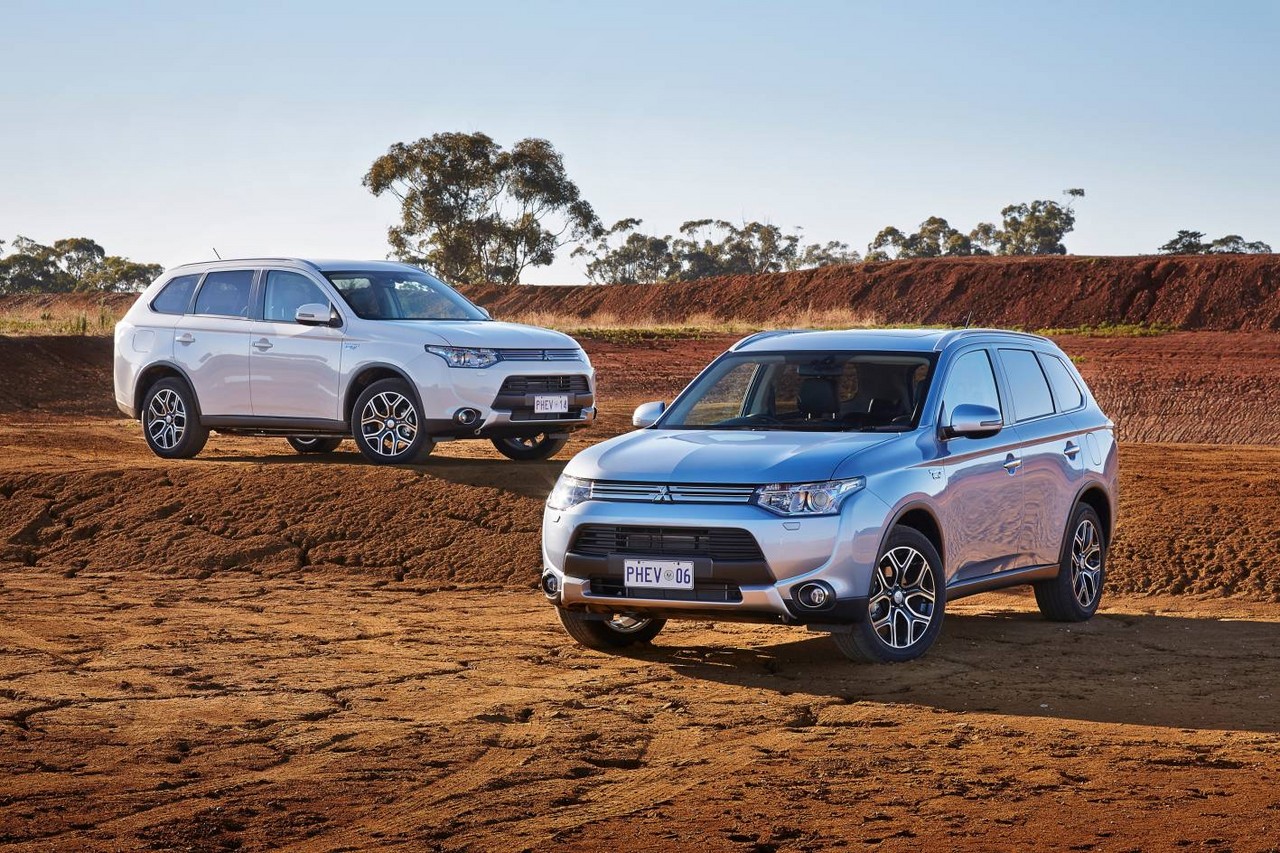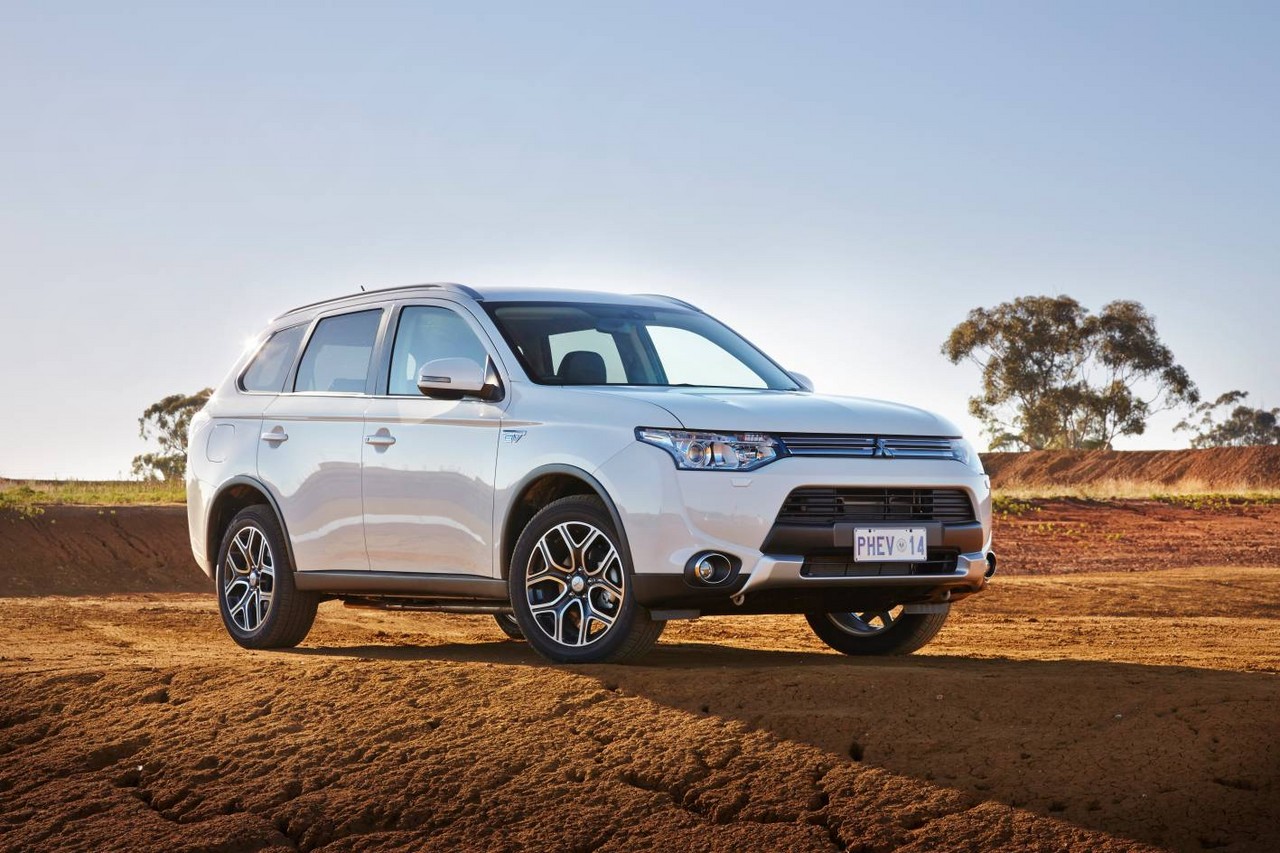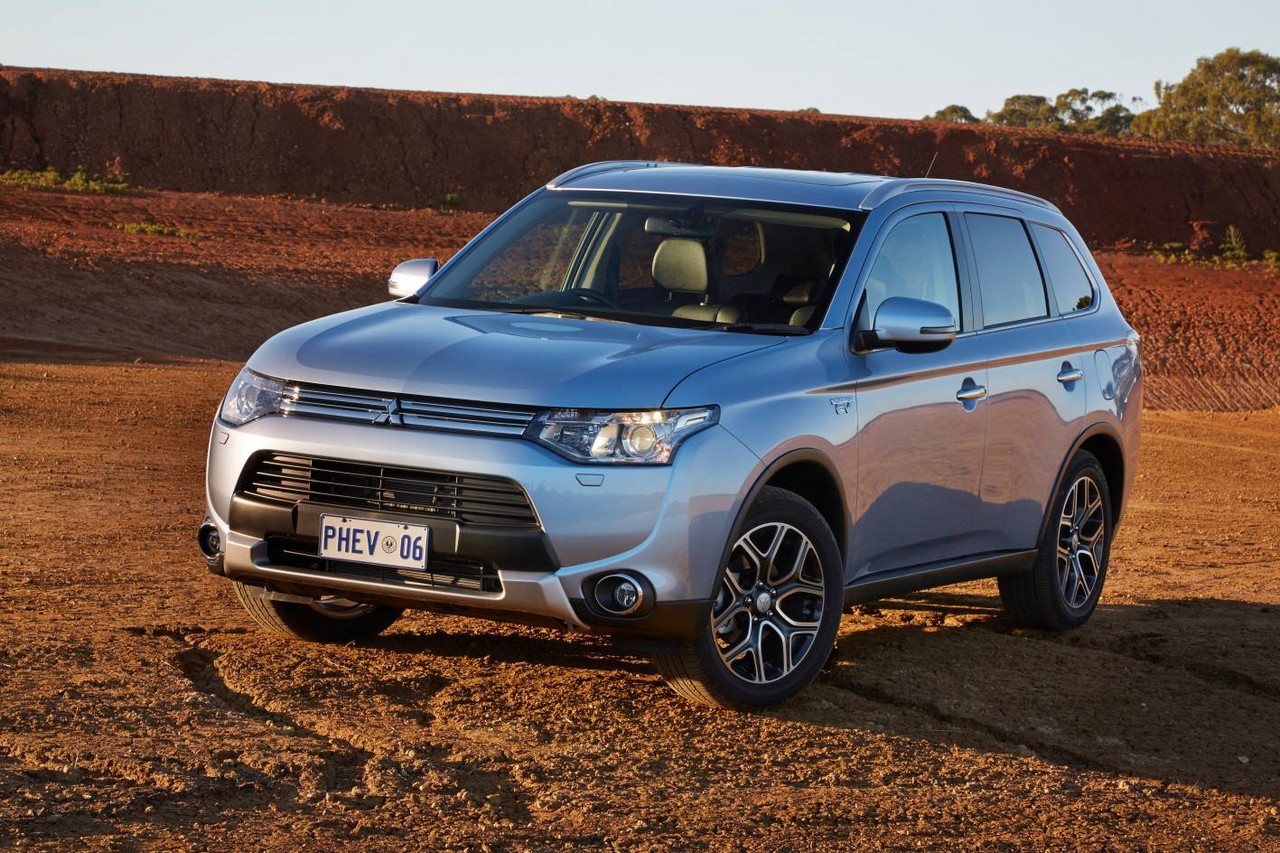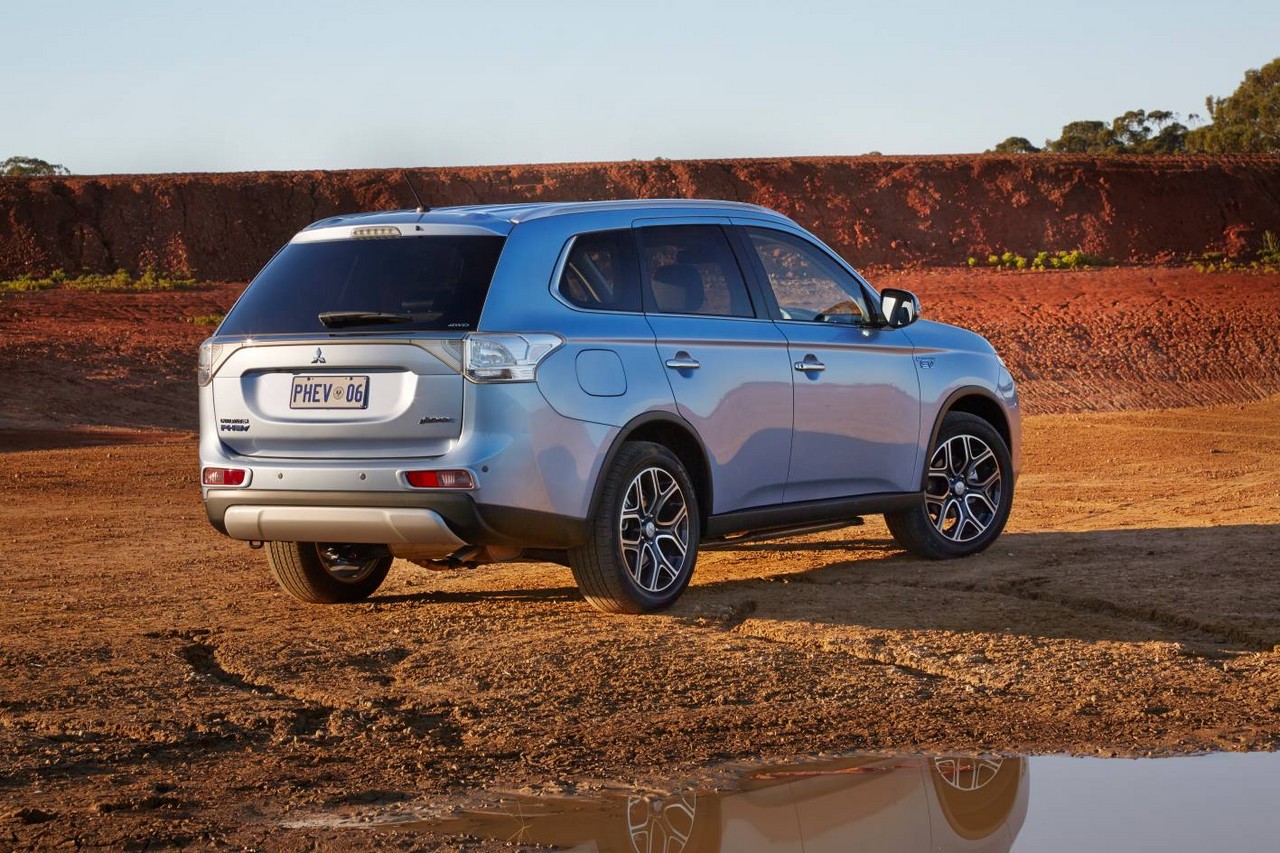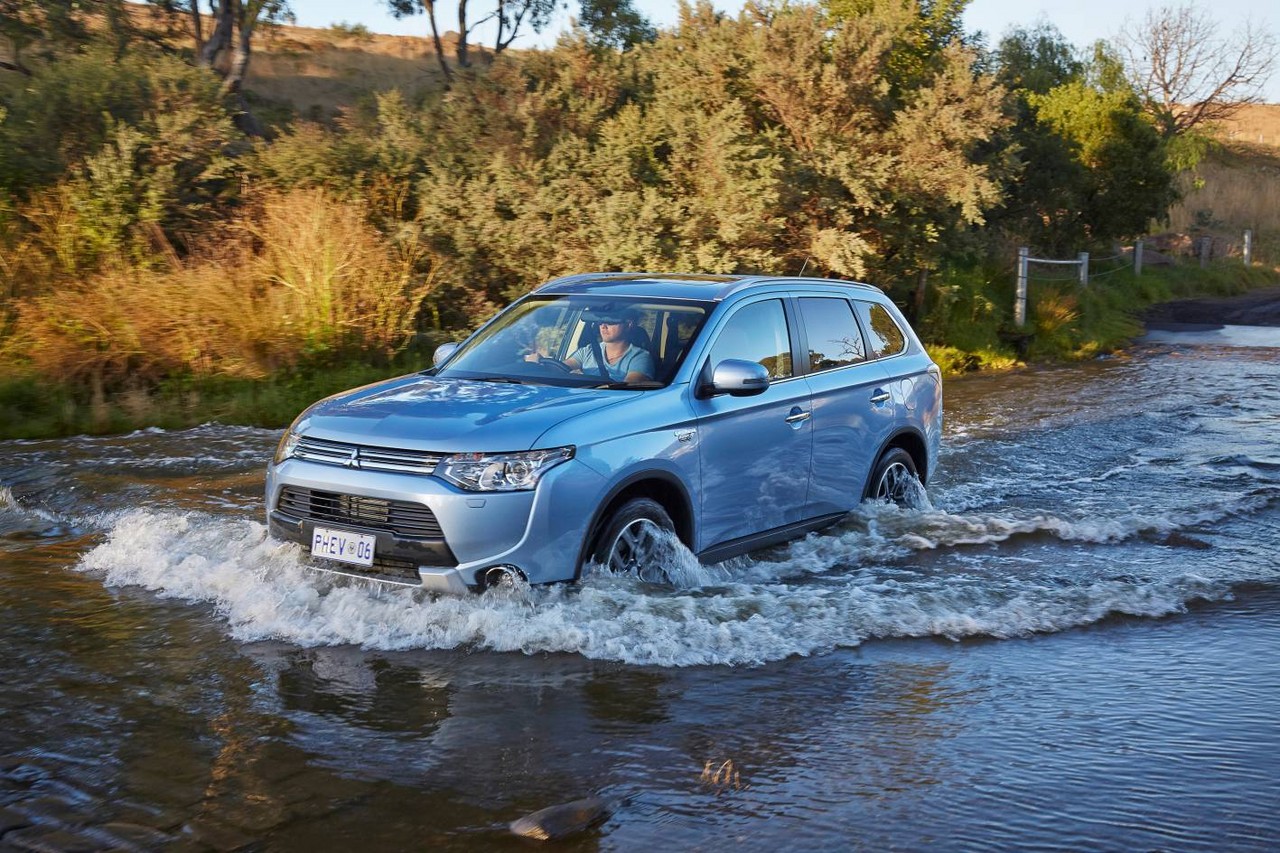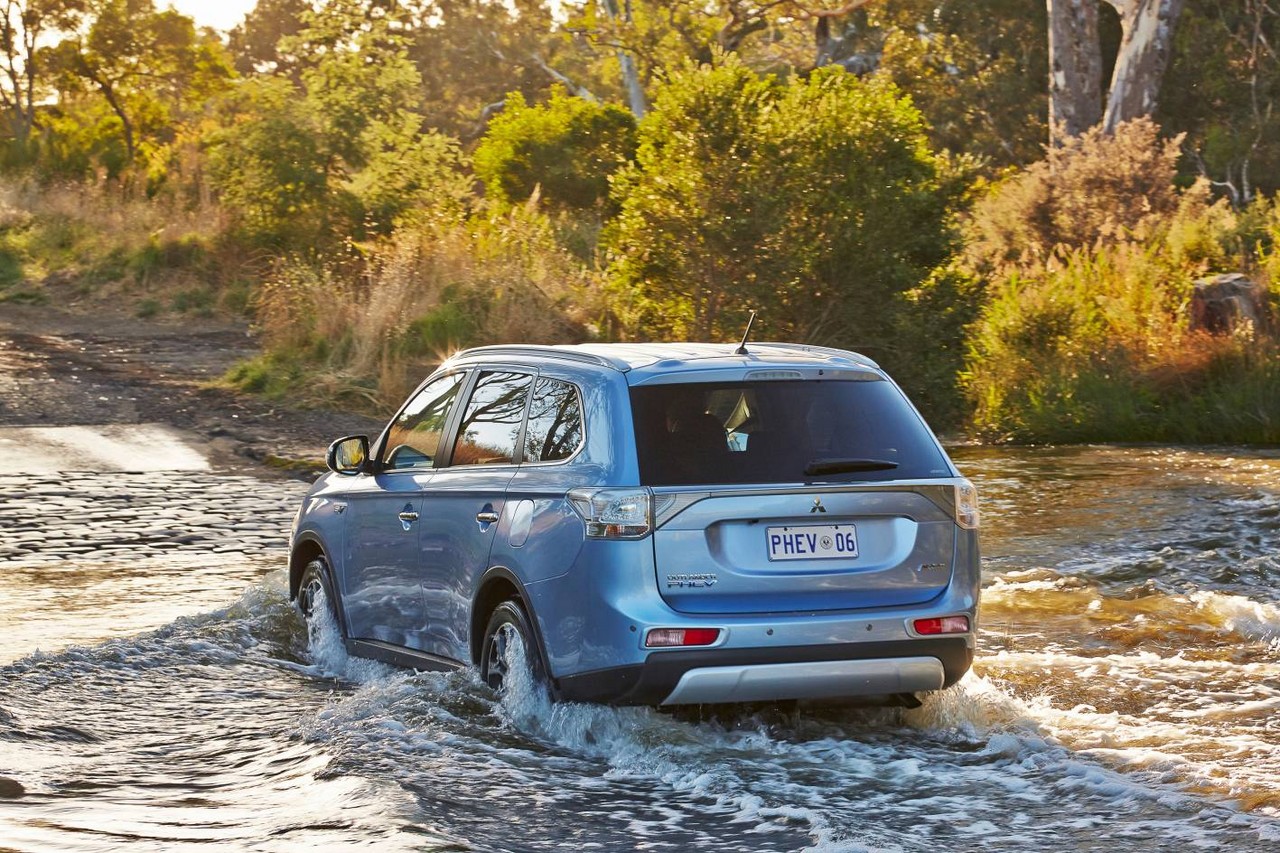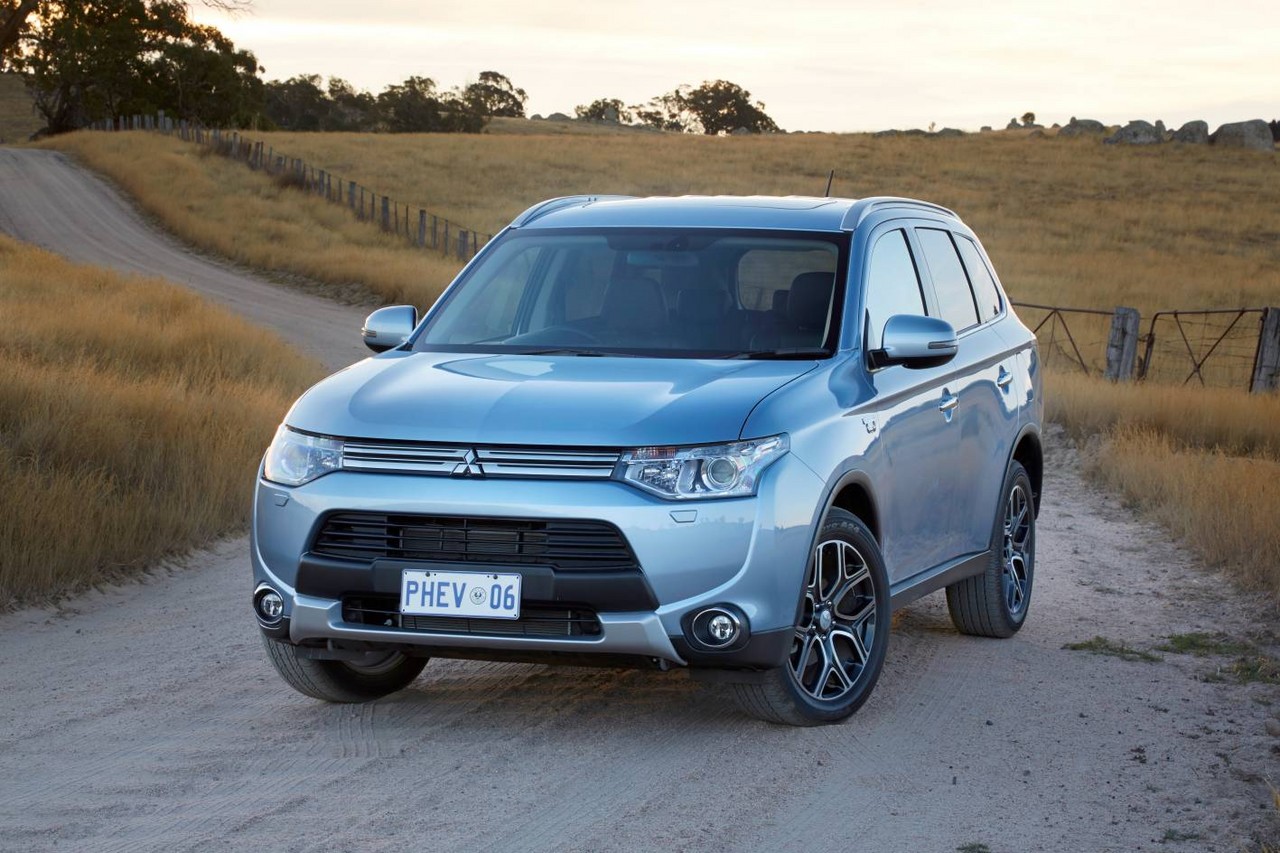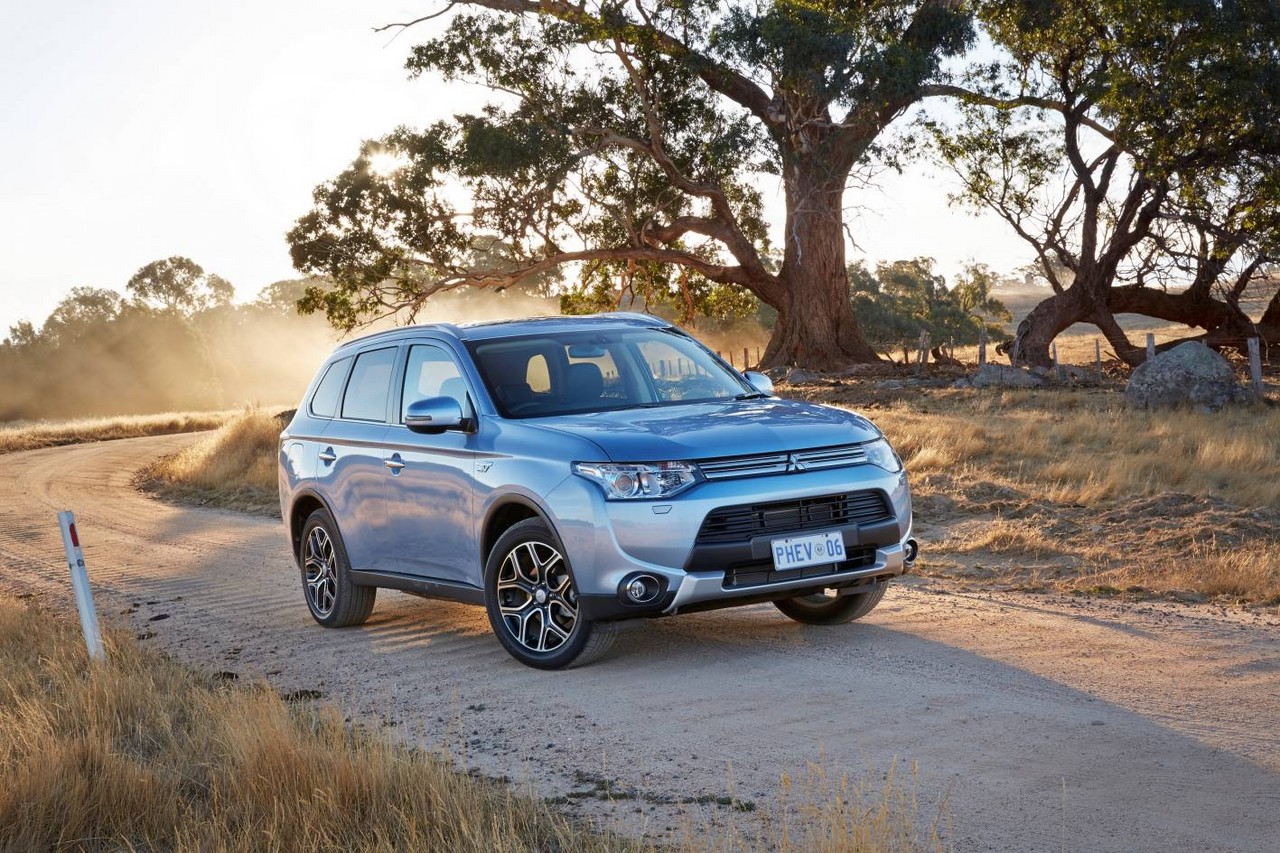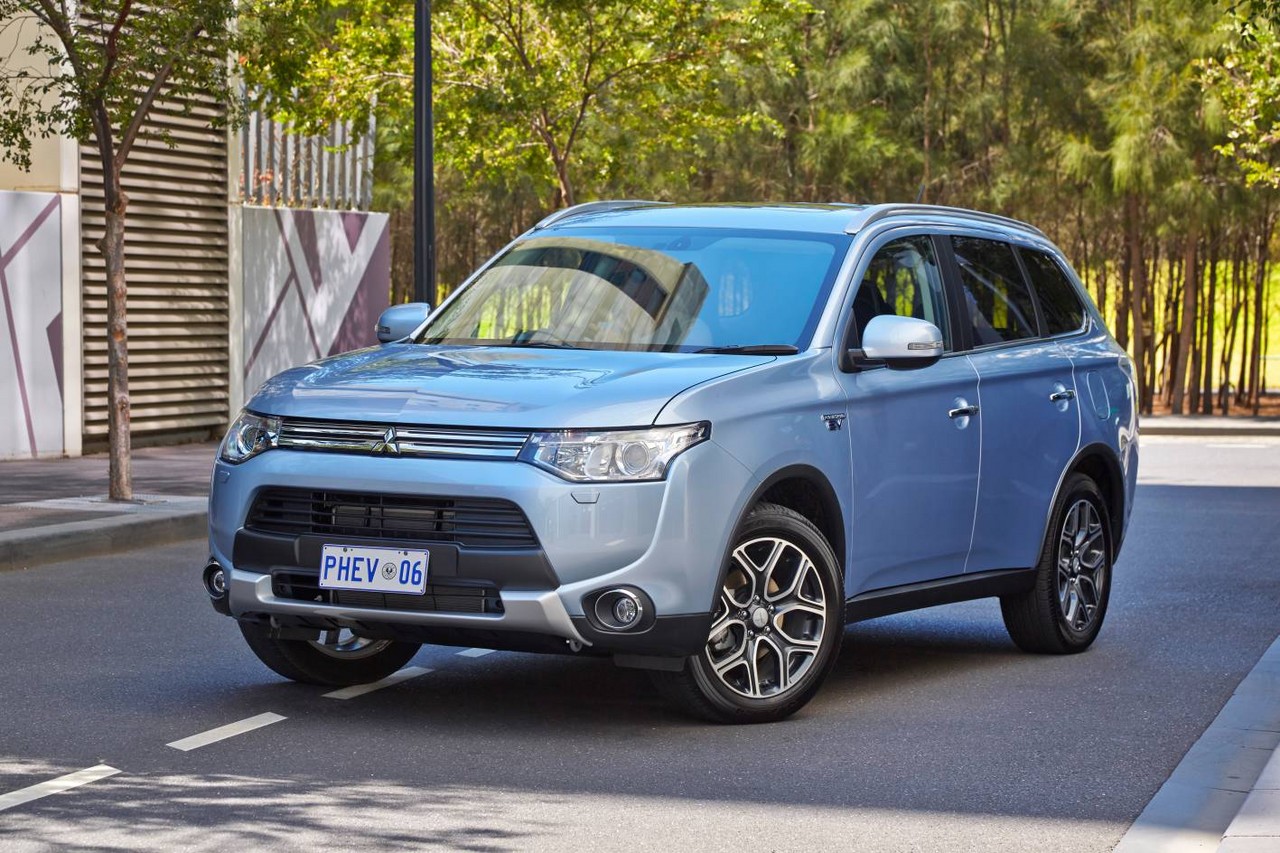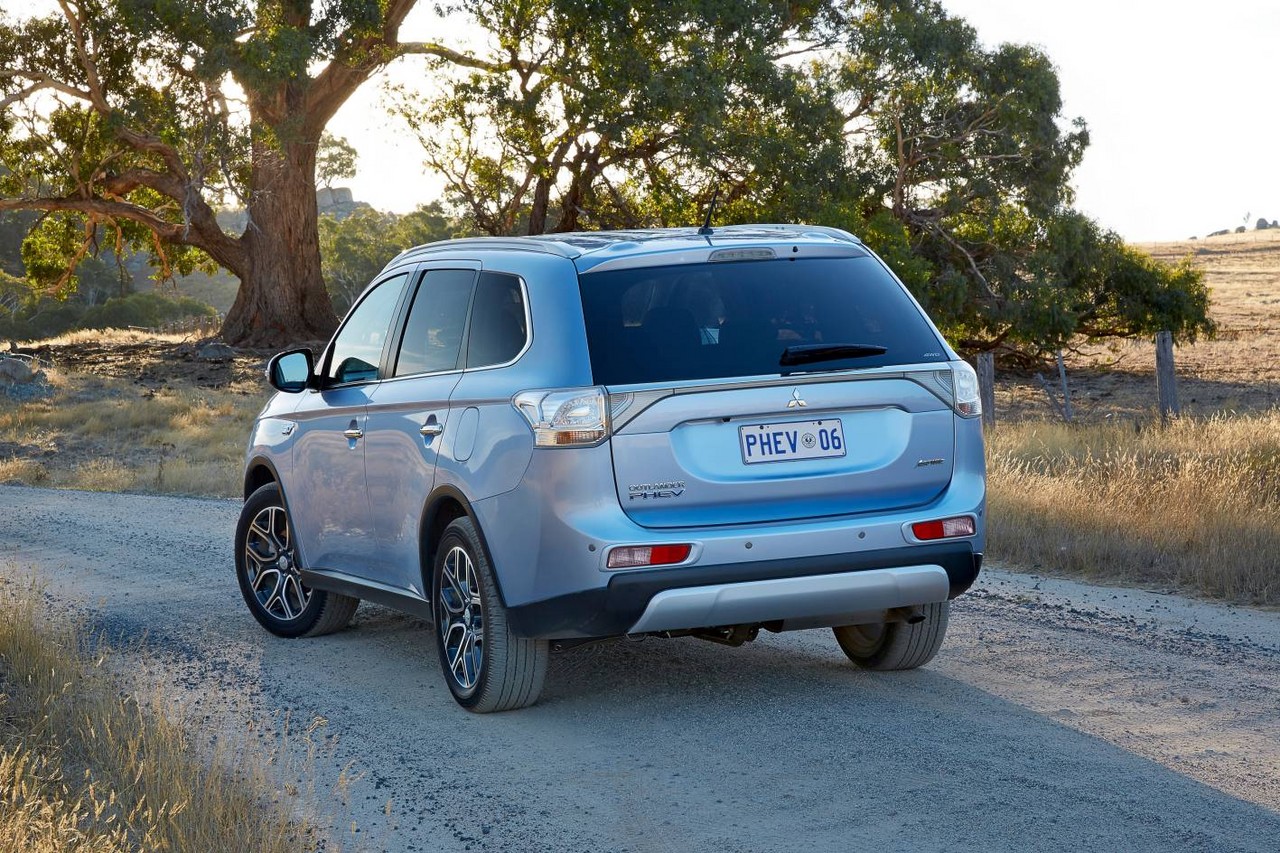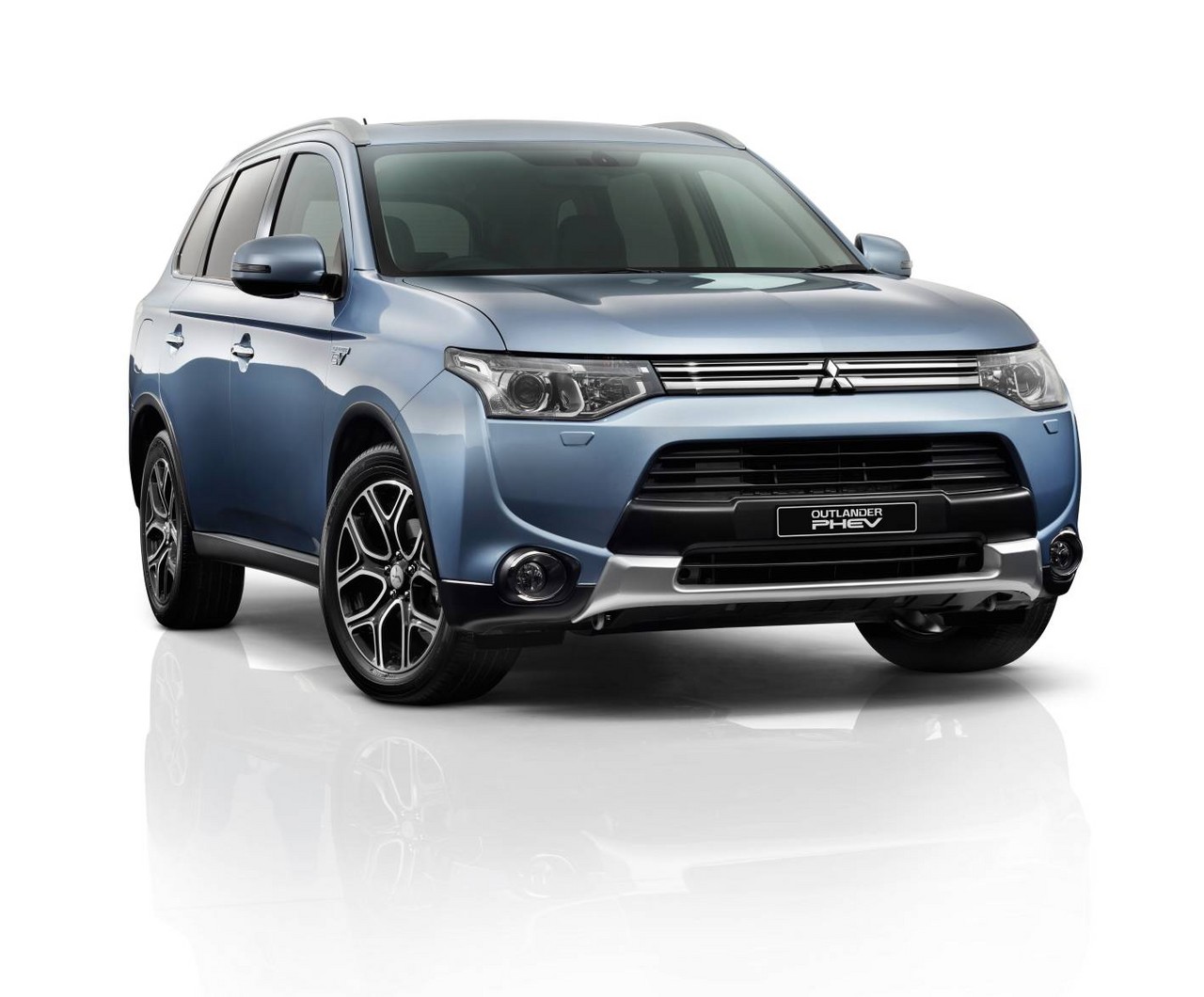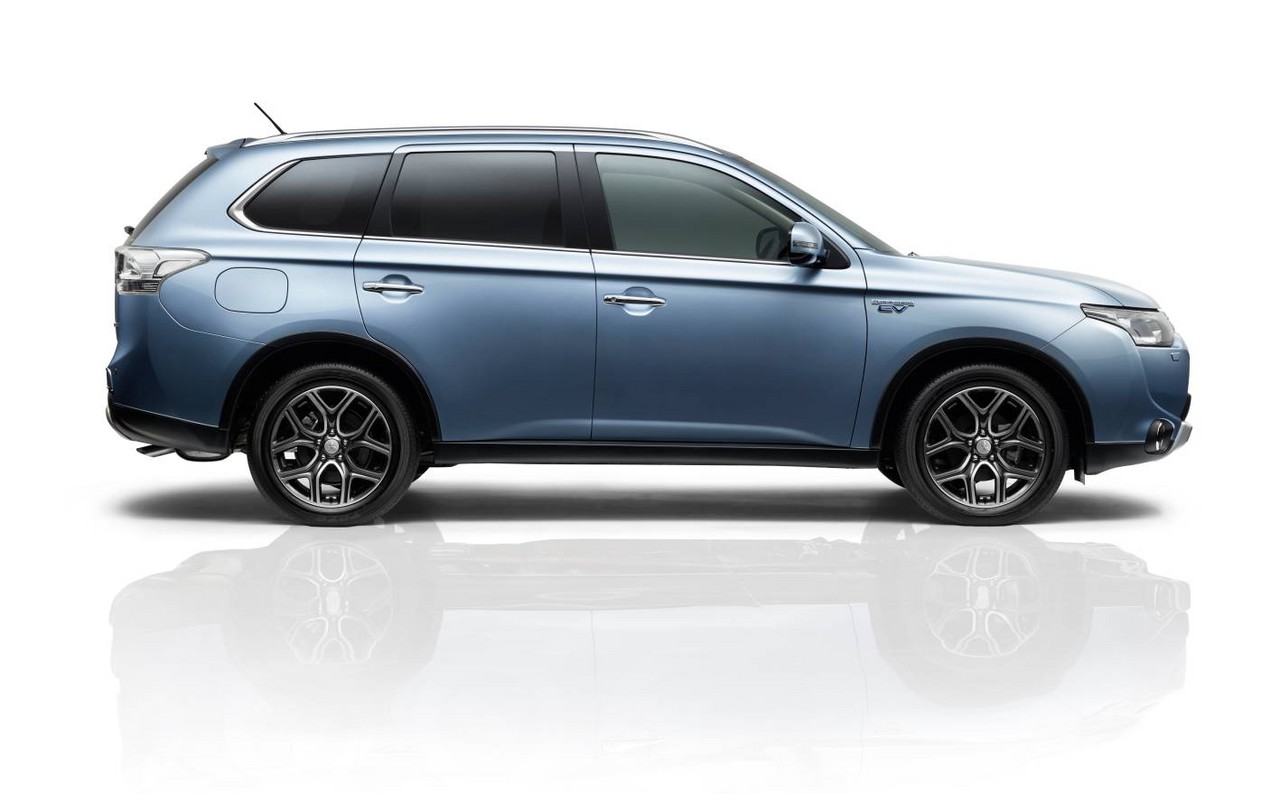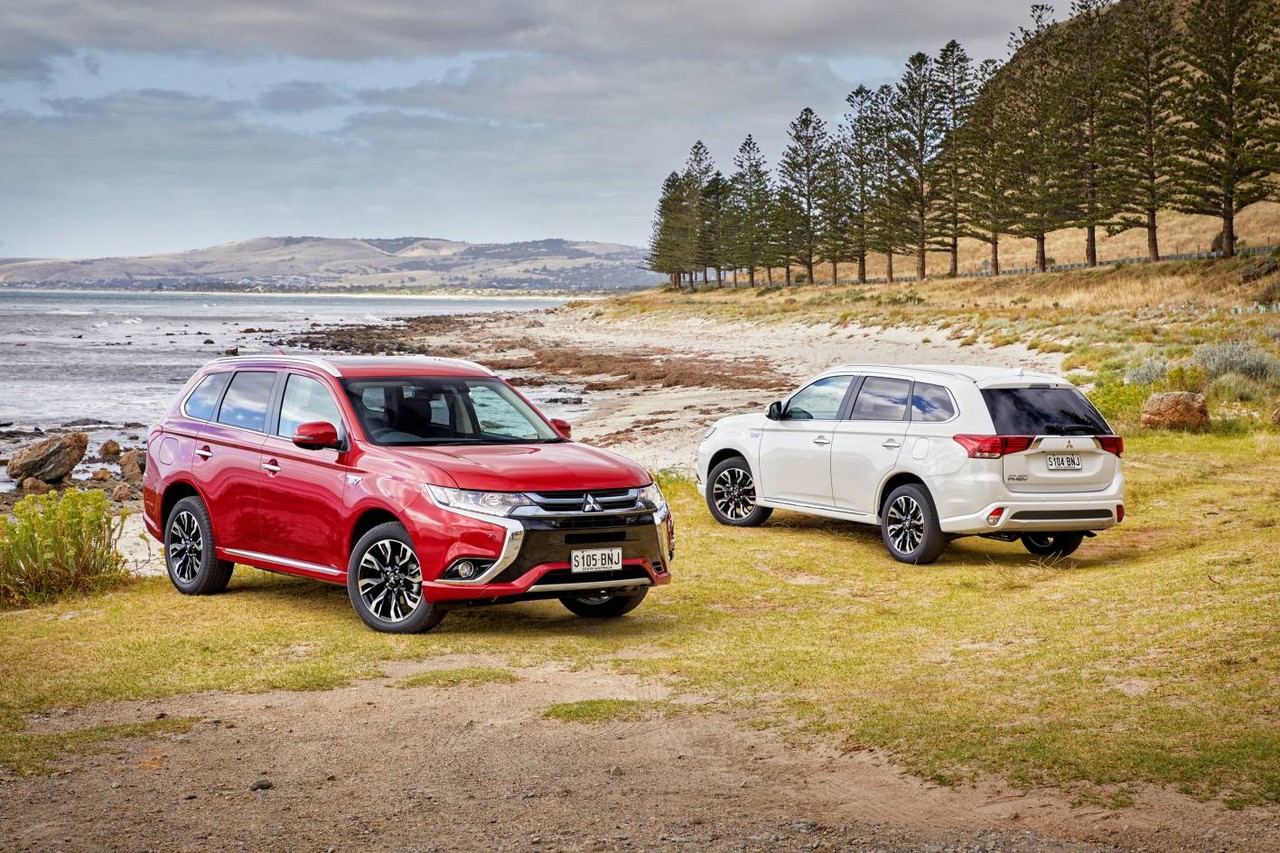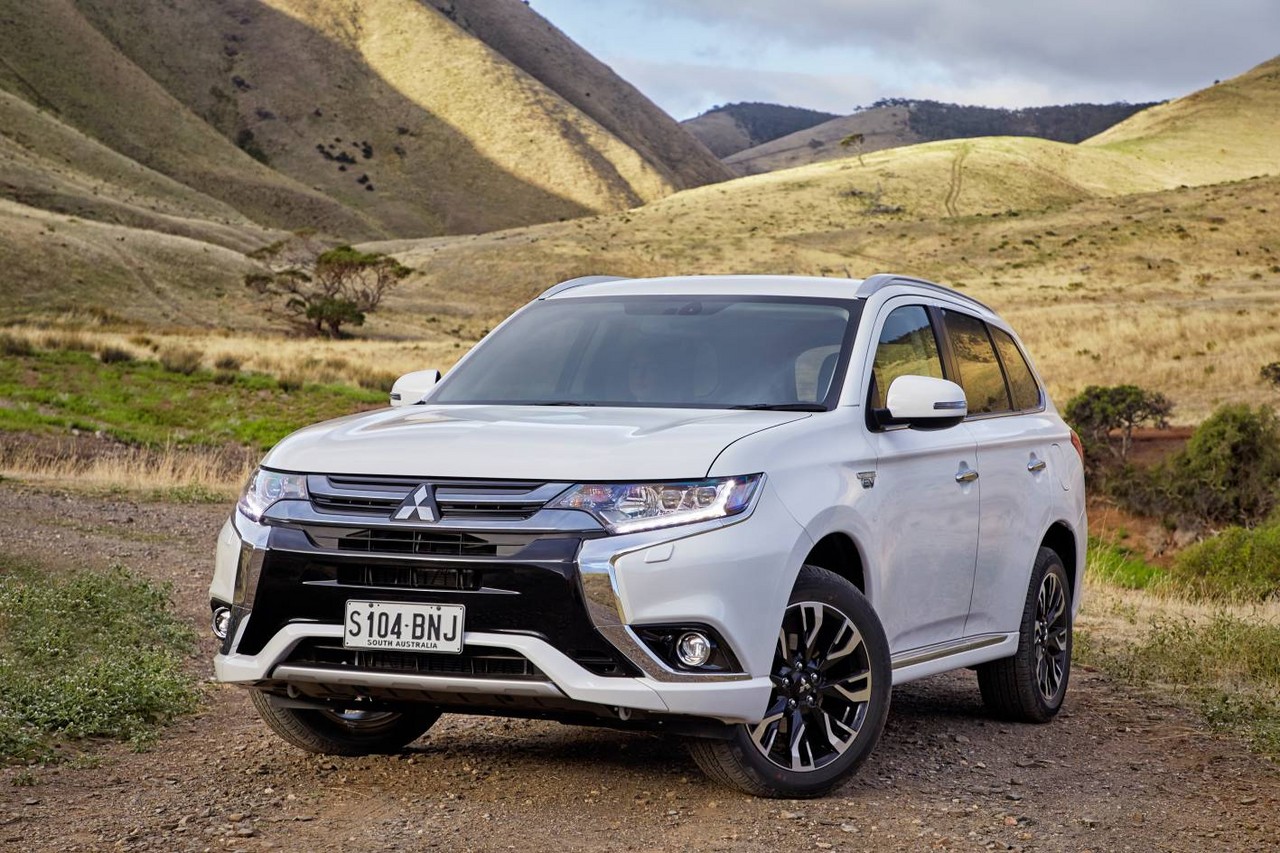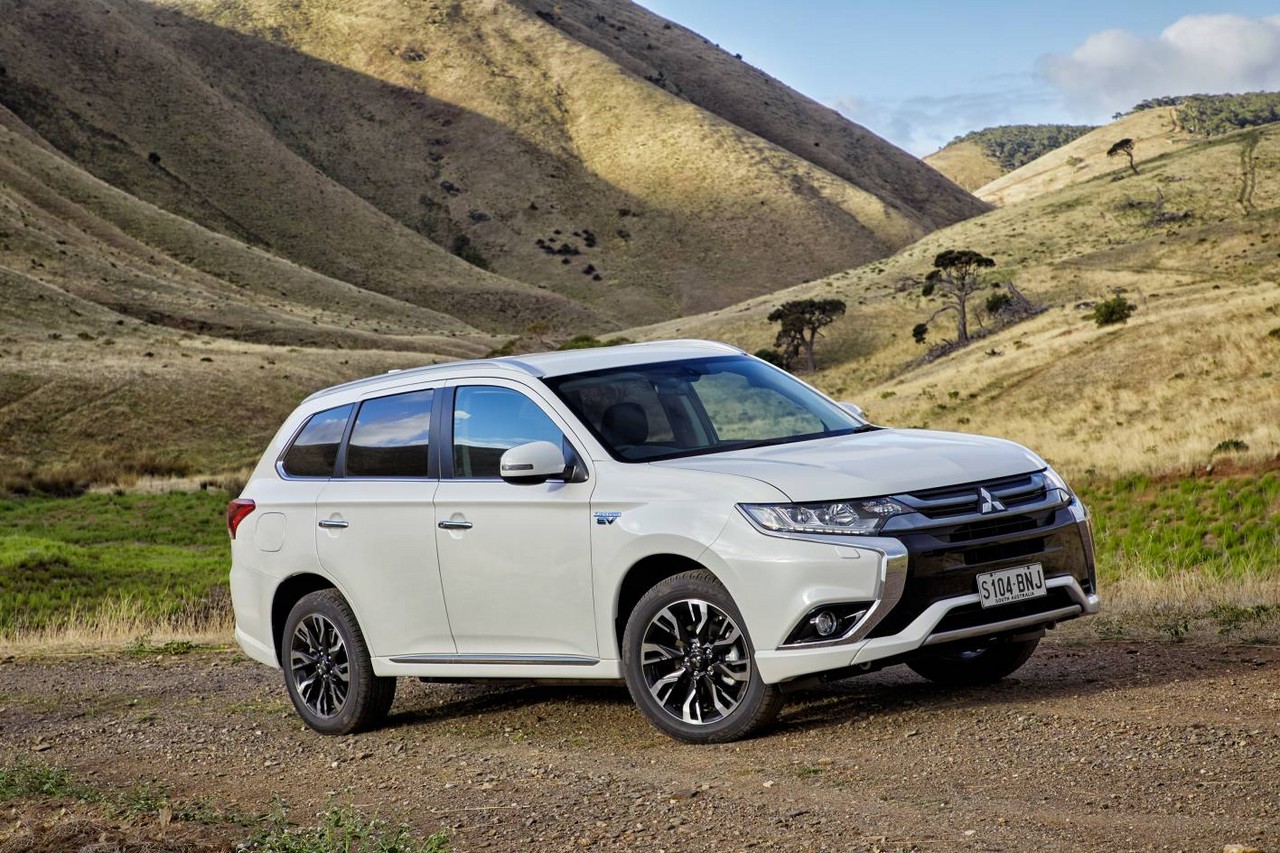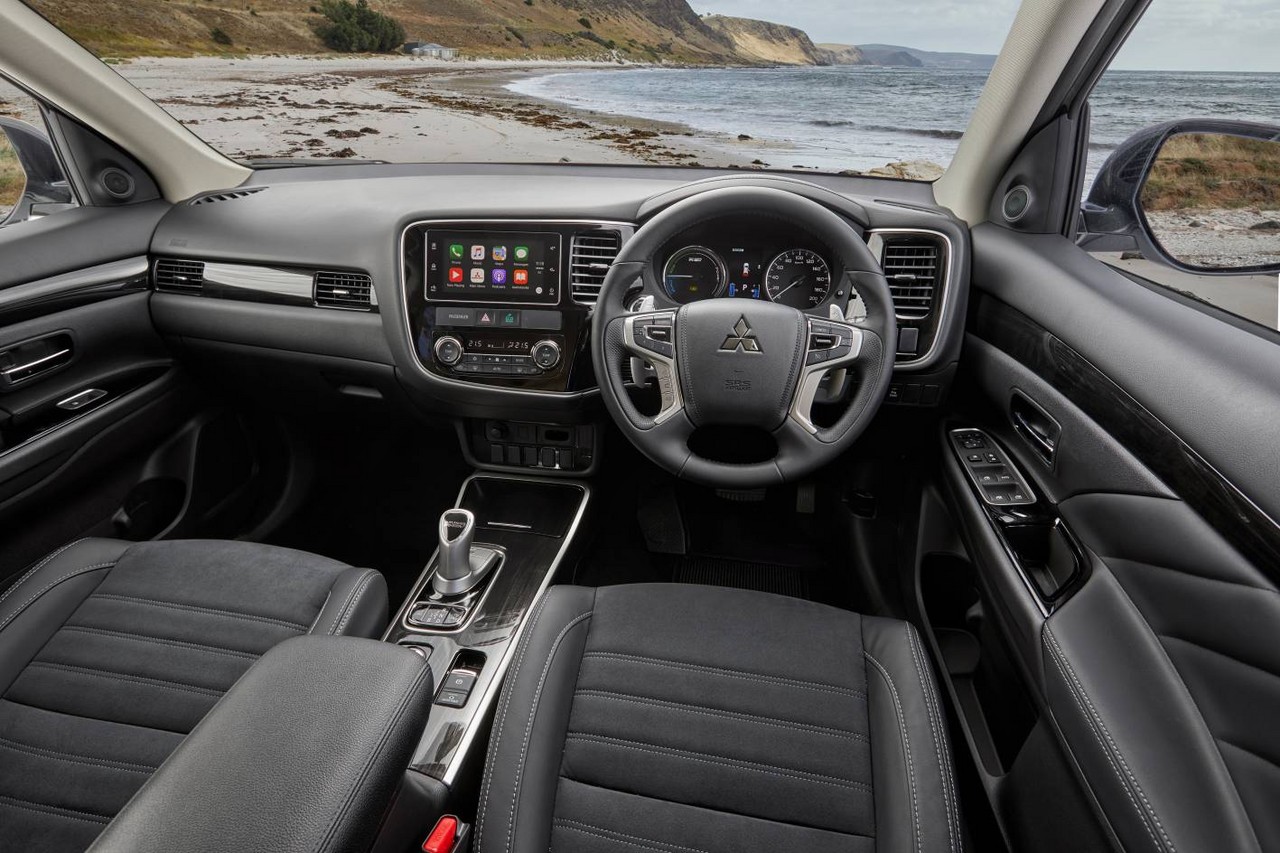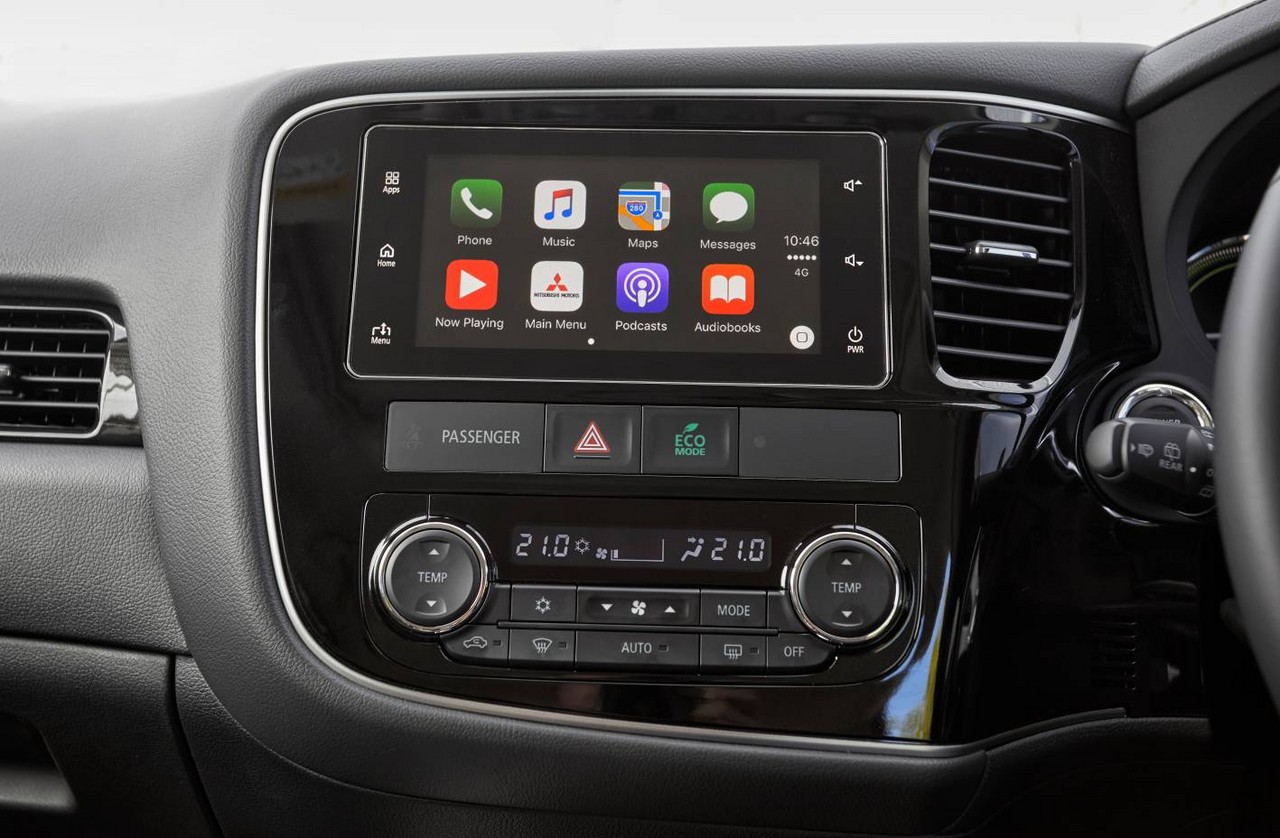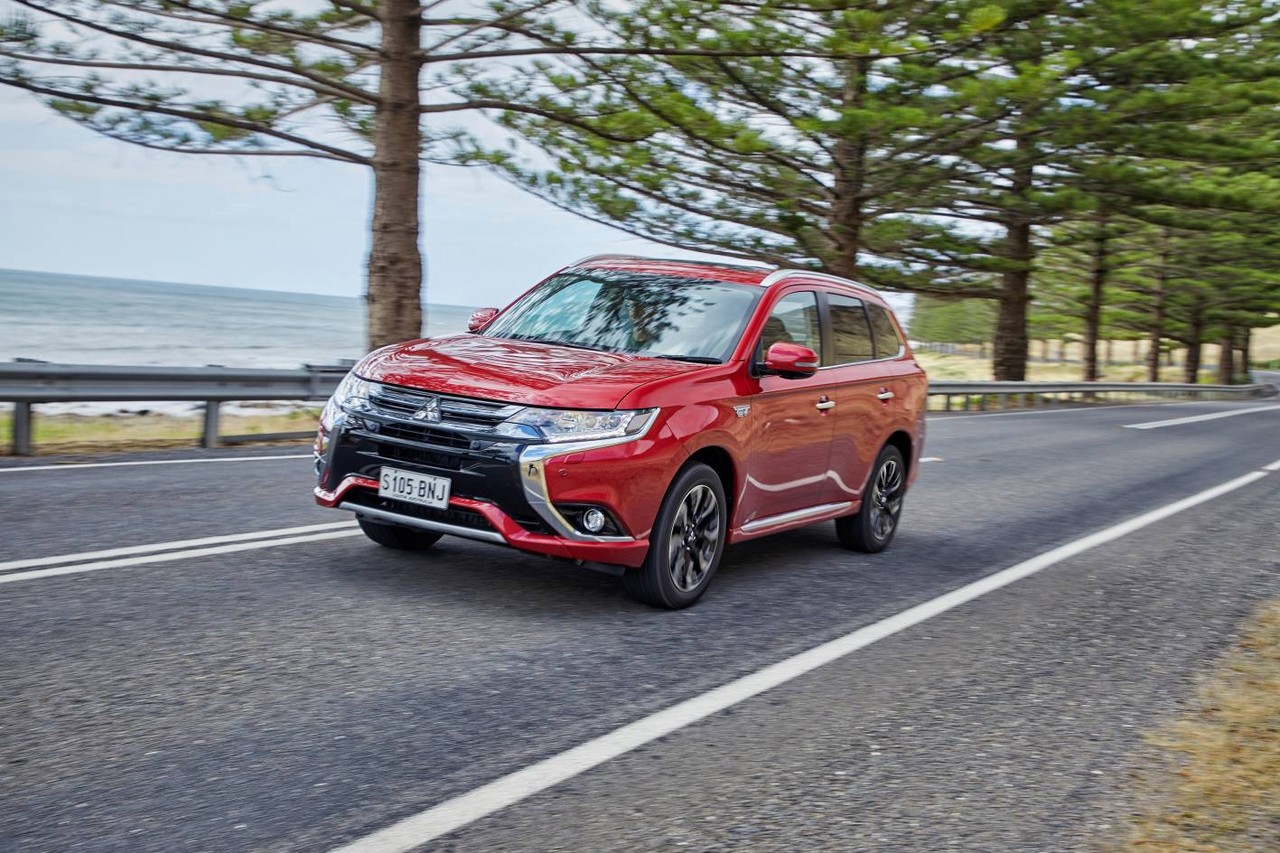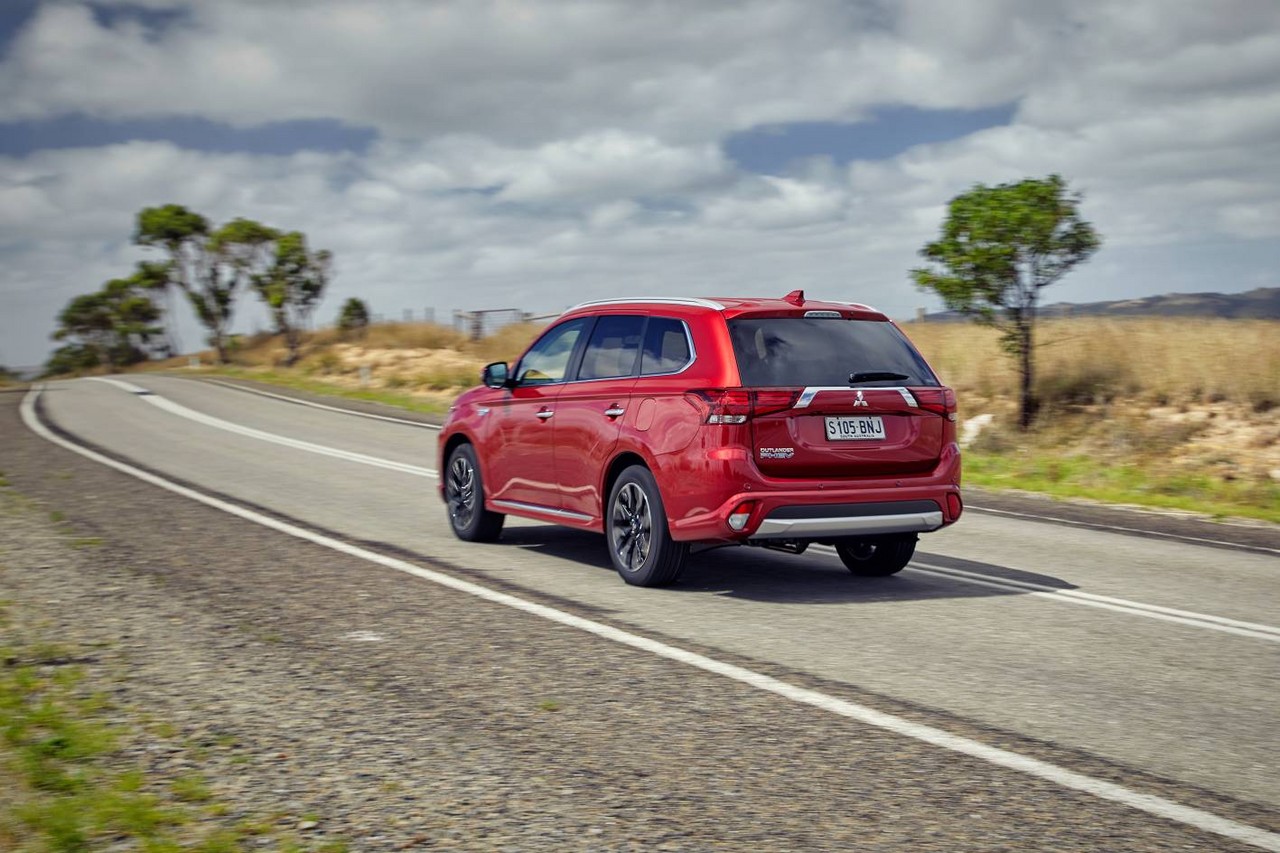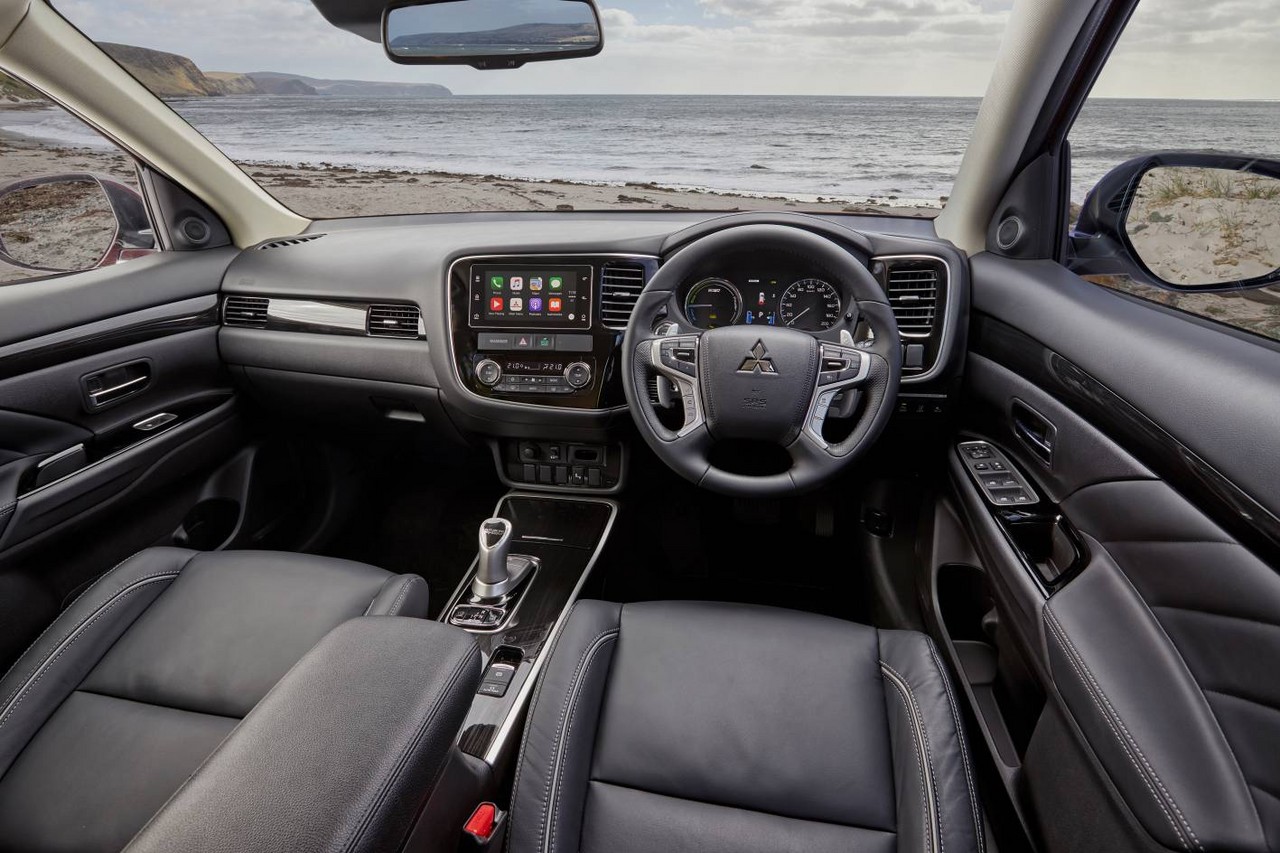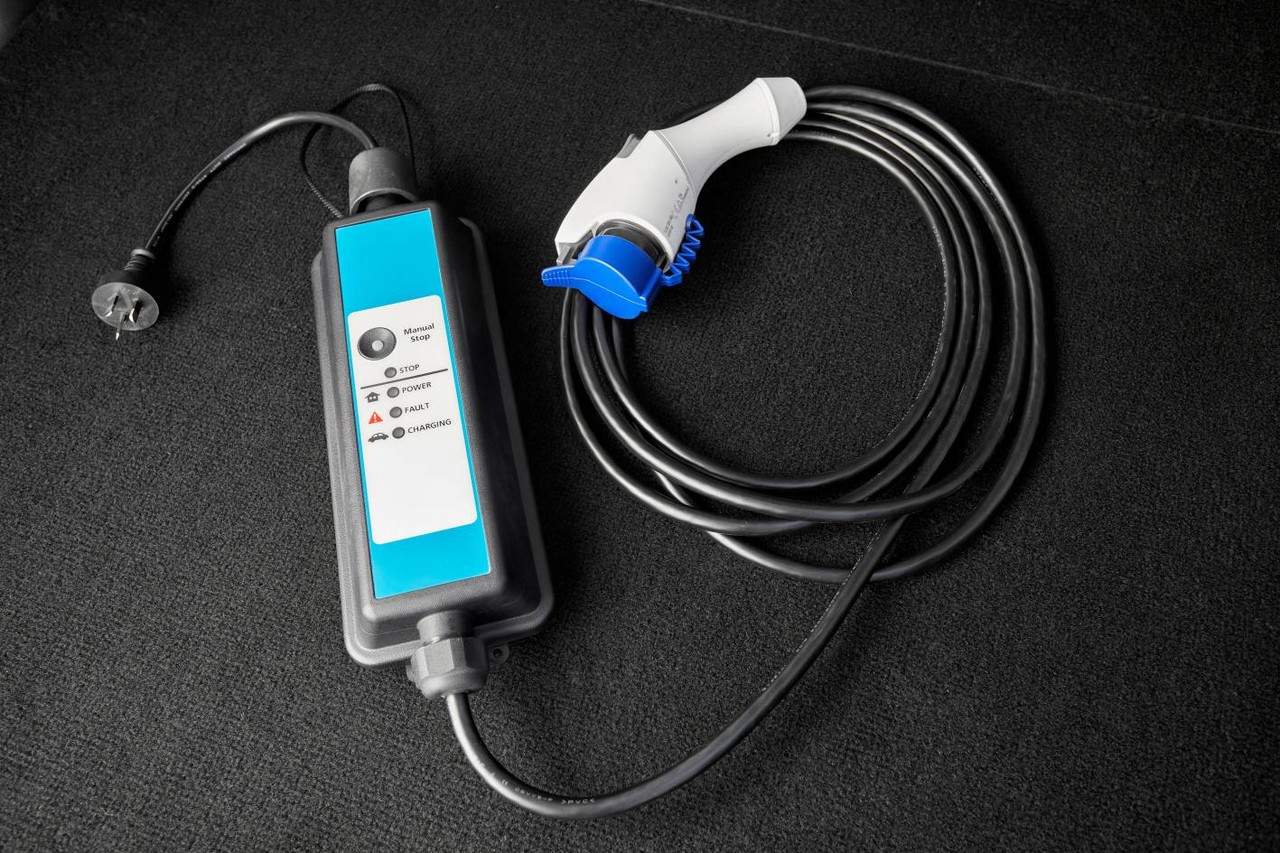
- Quiet and responsive hybrid powertrain
- Economical for short trips
- Comfortable ride
- Spacious interior
- Underwhelming fuel economy with petrol engine
- Confusing navigation and media system
- Batteries reduce boot space and their weight hurts dynamics
Review: Mitsubishi ZJ Outlander PHEV (2014-15)
Overview
Released in Australia in March 2014, the Outlander PHEV (Plug-In Hybrid Electric Vehicle) was a five-seat SUV. Manufactured in Okazaki, Japan, the powertrain for the Outlander PHEV consisted of:
- Mitsubishi’s 2.0-litre 4B11 petrol engine;
- A 60 kW/137 Nm oil-cooled front electric motor;
- A 60 kW/195 Nm water-cooled rear electric motor;
- A 12 kWh lithium-ion battery;
- A 70 kW output generator; and,
- Single-speed, fixed-reduction transaxles front and rear. The front transaxle would take up the motive power from either the front motor or the engine, while the rear transaxle only transmitted power from the rear motor.
The Outlander PHEV had three drive modes:
- EV Drive mode: the Outlander PHEV’s default drive mode in which the wheels were driven by the front and rear electric motors using battery power (without using the petrol engine);
- Series Hybrid mode: the electric motors would drive the vehicle using electricity generated by the petrol engine. This mode would be automatically engaged when battery charge fell below a predetermined level or when more performance was required (such as acceleration for overtaking or climbing steep inclines); and,
- Parallel Hybrid mode: the petrol engine would drive the wheels in conjunction with the electric motors. Similarly, this mode would be used when extra power was required for overtaking manoeuvres or climbing steep inclines.
The Outlander PHEV had an official electric-only range of 52km from a fully charged battery. This range, however, could be extended by the Series and Parallel drive modes and the battery management system. For the latter, the ‘Battery Save Mode’ would reduce drive battery power consumption by engaging the petrol engine, while Battery Charge Mode would use the petrol engine to generate and store battery power. With the vehicle stationary, the driver could charge the battery to around 80 per cent capacity in 40 minutes (depending on air temperature and climate control settings) by consuming around 3 litres of petrol. The Outlander PHEV’s battery could be fully recharged in five hours by using a dedicated 15 amp power outlet. From late 2014, the Outlander PHEV had a 10-amp compatible charging input.
The Outlander PHEV had a regenerative braking system which could use the electric motors to generate electrical energy when the vehicle was decelerating. The degree of energy recovered by the regenerative braking system could be controlled by a selector lever (for B3 and B5 settings) or paddle selectors on the steering wheel (from B0 to B5).
| Motor | Trans. | Peak power | Peak torque | |
|---|---|---|---|---|
| Outlander PHEV | 2.0-litre petrol I4 | 1sp reduction gear | 87 kW at 4500 rpm | 186 Nm at 4500 rpm |
| Front electric motor | 60 kW | 137 Nm | ||
| Rear electric motor | 1sp reduction gear | 60 kW | 195 Nm | |
| Combined | 120 kW | 332 Nm | ||
All-wheel drive system
Mitsubishi described the Outlander PHEV as having a ‘Twin Motor 4WD’ system, though power was provided independently to the front wheels (from the front motor and/or engine) and rear wheels (from the rear motor). The Twin Motor 4WD system, however, was combined with Mitsubishi’s ‘Super All Wheel Control’ (S-AWC) integrated vehicle dynamics control system which combined front- and rear-wheel drive control and left and right wheel brake control. The driver was also able to select from a ‘Normal Mode’ for standard driving conditions and a ‘Lock Mode’ which increased the wheel speed differential limiting force.
Dimensions and suspension
The Mitsubishi Outlander PHEV was 4655 mm long, 1800 mm wide (excluding mirrors), 1680 mm tall and had a 2670 mm long wheelbase; kerb weight of 1810 kg. Inside, cargo capacity for the Outlander PHEV was 463 litres, though this increased to 888 litres with the rear seats folded.
The Outlander PHEV had MacPherson strut front suspension and independent, multi-link rear suspension. Furthermore, maximum towing capacity for the Outlander PHEV was 750 kg unbraked and 1500 kg braked.
Safety equipment
Standard safety equipment for the Mitsubishi Outlander PHEV included dual front airbags, a driver’s knee airbag, front side airbags, full-length curtain airbags, ABS, electronic brake force distribution, brake assist, electronic stability control, traction control and front seatbelts with pretensioners and load limiters. The Outlander PHEV also had an Acoustic Vehicle Alert System (AVAS) which would operate when the Outlander was travelling at speeds below 35 km/h and the brake pedal was not deployed to warn pedestrians of the Outlander PHEV’s approach.
The Outlander PHEV Aspire was further equipped with:
- Adaptive Cruise Control (ACC) which used a radar system to monitor the distance to the vehicle ahead and enabled the driver to follow at one of three selectable distances. The ACC system would then regulate motive power, apply the brakes and bring the vehicle to a stop as necessary; and,
- Forward Collision Mitigation (FCM) which used the same radar system to detect slow or stationary vehicles ahead. Initially, a warning alarm would sound, followed by autonomous application of the brakes to avoid or reduce the severity of a collision.
Euro NCAP testing and ANCAP rating
In Euro NCAP testing , the standard Mk.3 Outlander received a five star safety rating which included a 94 per cent adult occupant protection rating and an 83 per cent child occupant protection rating. Based on information provided to ANCAP, the results from this testing were applied to the Outlander PHEV and ANCAP awarded the Outlander PHEV a five star adult occupant protection rating with a score of 35.58 out of 37.
In separate Euro NCAP testing of the Outlander PHEV , a five star safety rating was conferred which included an 88 per cent adult occupant protection rating and an 84 per cent child occupant protection rating.
Features: Outlander PHEV
Standard features for the Outlander PHEV included 18-inch machine faced alloy wheels with 225/55 R18 tyres, an eight speaker sound system with MP3-compatibility, a CD player and auxiliary inputs (SD card/USB/iPod), Bluetooth mobile phone connectivity with steering wheel controls and voice control, a satellite navigation system with a seven-inch colour touch screen and 3D maps, dual-zone climate control air conditioning, cruise control, high intensity discharge (HID) headlights wish washers, front fog lights, a reversing camera, rear parking sensors, automatic headlights, rain-sensing wipers, a leather-wrapped steering wheel, 60:40 split and folding rear seats, remote central locking with proximity key, power windows and mirrors, a height and reach adjustable steering wheel, height adjustable driver’s seat, 12 volt power socket, cargo blind, rear privacy glass, silver roof rails, a trip computer, an alarm and immobiliser.
The Outlander PHEV Aspire variant was further equipped with leather seat trim, heated front seats, a six-way power adjustable driver’s seat, a power sliding sunroof and a power-operated tailgate with remote operation. The Aspire variants also featured a Wi-Fi based EV remote system (via the Outlander PHEV smartphone app) which provided functions such as scheduled battery charging, on-demand air conditioning, scheduled climate control, vehicle status updates and headlight activation. Visually, the Aspire variants could be identified by their chrome door handles and chrome side window garnish.
Brochure
Related links
- Product Information: Mitsubishi Outlander PHEV (March 2014)
- Specifications: Mitsubishi Outlander PHEV (March 2014)
Review: Mitsubishi ZK Outlander PHEV (2017-21)
Overview
While production of the Mitsubishi ZK Outlander PHEV commenced in the first quarter of 2015, Mitsubishi Motors Australia opted not to import this vehicle and instead waited until April 2017 when a DC fast charge socket was introduced; with the fast charge socket, the battery could be recharged to 80 per cent of its capacity in 25 minutes. Furthermore, the Mitsubishi ZK Outlander PHEV range consisted of LS and Exceed variants.
The ZK Outlander PHEV provided better fuel economy than its predecessor due to reductions in engine friction and ‘overall system optimisation’. Improvements to electric motor efficiency increased the vehicle’s electric-only range to 54 km, while combined fuel consumption over the ADR 81/02 test cycle was 1.7 litres per 100 km. Furthermore,
- The hybrid EV and motor control systems were also revised for improved launch feel; and,
- An ‘EV’ switch was introduced which enabled the driver to operate the vehicle in EV mode without the petrol engine provided the batteries had sufficient charge.
Visual and interior changes
Visually, the Mitsubishi ZK Outlander PHEV could be identified by Mitsubishi’s ‘Dynamic Shield’ design concept which included a dark chrome and silver plated grille, silver skid plates (front and rear), LED headlamps, day time running lamps, fog lamps with chrome bezels, a new rear bumper, shark fin antenna, chrome tailgate garnish, LED rear combination lamps and a rear fog lamp. The Mitsubishi Outlander PHEV also had 18-inch black and polished alloy wheels, silver roof rails and chrome door sill garnishes.
Inside, the ZK Outlander PHEV introduced additional soft touch materials, a four spoke steering wheel, new accent trims (for the doors, dashboard and centre console), new material for the headlining and ‘stitching highlights’ for the instrument panel. According to Mitsubishi, the stiffer bolsters for the front seats provided greater lateral support.
September 2018 changes
In September 2018, the Mitsubishi Outlander PHEV range was revised and consisted of ES (replacing LS), ES ADAS and Exceed variants. Visually, the post-September 2018 Outlander PHEV could be identified by its twin-blade grille, front and rear bumpers, and new 18-inch alloy wheel design. Insider, there were redesigned front seats, a soft pad leather armrest for the centre console, a rear air conditioning outlet, one-touch power window operation and illuminated power window switches.
Other changes for the post-September 2018 Outlander PHEV included:
- For the suspension, larger diameter front struts and rear shock absorbers for greater ride comfort and body control;
- New structural bonding to improve body rigidity; and,
- A faster steering ratio.
| Motor | Trans. | Peak power | Peak torque | |
|---|---|---|---|---|
| Outlander PHEV | 2.0-litre petrol I4 | 1sp reduction gear | 87 kW at 4500 rpm | 186 Nm at 4500 rpm |
| Front electric motor | 60 kW | 137 Nm | ||
| Rear electric motor | 1sp reduction gear | 60 kW | 195 Nm | |
| Combined | 120 kW | 332 Nm | ||
Body and suspension
Like the ZK Outlander, changes for the ZK Outlander PHEV included:
- A more rigid body and suspension due to reinforcements and bracing for the front firewall, front top cowl, rear sub-frame and rear wheel housing;
- Re-tuned, ‘dynamic’ dampers front and rear for greater improved ride quality; and,
- For greater refinement, noise-isolating windscreen and tailgate glass, additional sound insulation and new rear differential dampers.
Safety equipment
Standard safety equipment for the Mitsubishi Outlander PHEV was unchanged.
Released in September 2018, the Mitsubishi PHEV EV ADAS was equipped with:
- Forward Collision Mitigation (FCM): used the same radar system to detect slow or stationary vehicles ahead. Initially, a warning alarm would sound, followed by autonomous application of the brakes to avoid or reduce the severity of a collision;
- Adaptive Cruise Control (ACC): used a radar system to monitor the distance to the vehicle ahead and enabled the driver to follow at one of three selectable distances. The ACC system would then regulate motive power, apply the brakes and bring the vehicle to a stop as necessary;
- Lane Departure Warning (LDW): used a camera to monitor the vehicle’s position within its lane and, if it departed from its lane without having applied the indicators, a warning tone would sound and a warning would appear on the multifunction display; and,
- Automatic High Beam (AHB): monitored the headlights and fog lights of oncoming vehicles as well as street lighting and ambient light levels to automatically switch between high and low beam. As such, high beams were automatically activated above 40 km/h in low light conditions when no other vehicle was present.
Beyond this, the Mitsubishi ZK Outlander PHEV Exceed was further equipped with:
- Ultrasonic misacceleration Mitigation System (UMS): reduced the likelihood and severity of collisions with obstacles four metres in front or behind the vehicle by automatically applying the brakes when driver unintentionally accelerated from speeds under 10 km/h;
- Blind Spot Warning (BSW) and Lane Change Assist (LCA): provided an audible alert and displayed a blinking light in the door mirror when there was a collision risk with a vehicle that was approaching from behind that was within 3.5 metres from the Outlander PHEV’s side or 70 metres from its rear bumper; and,
- Rear Cross Traffic Alert (RCTA): when reversing, RCTA used the rear parking sensors to detect approaching traffic that may cross the Outlander PHEV’s path and would alert the driver via a warning tone, an indicator light in the combination meter and a blinking light in the side door mirror.
Features: Mitsubishi Outlander PHEV ES and LS
The standard infotainment system for the ZK Outlander PHEV consisted of Mitsubishi’s ‘Smartphone Link Display Audio’ which had a seven-inch touchscreen, six speakers, a digital radio tuner (DAB), two USB inputs, Bluetooth mobile phone connectivity and audio streaming with voice control, and Android Auto and Apple CarPlay smartphone integration.
Other standard features for the Mitsubishi Outlander PHEV ES and LS included 18-inch alloy wheels, dual-zone climate control air conditioning, cloth seat trim with ‘leather look’ bolsters, a power adjustable driver’s seat, cruise control, LED headlamps with washers, LED daytime running lights and front fog lamps, dusk-sensing headlights, rain-sensing wipers, rear parking sensors, a rear view camera, a leather-wrapped steering wheel, 60:40 split folding rear seats, remote central locking with proximity key, power adjustable mirrors, power windows, tilt and telescopic steering wheel adjustment, push-button start, an electric park brake, a 12 volt accessory power socket, illuminated vanity mirrors, rear privacy glass, silver roof rails, a trip computer, an alarm and immobiliser.
Released in September 2018, the Mitsubishi Outlander PHEV ES had microsuede seat trim with ‘leatherette’ bolsters and ‘silver pinstripe’ trim for the dashboard and doors.
Features: Mitsubishi Outlander PHEV Exceed
Compared to the LS, the Mitsubishi Outlander PHEV Exceed was further equipped with leather seats, heated front seats, front seatback pockets, front parking sensors, a surround view camera system (Mitsubishi’s ‘Multi Around Monitor’), an electrochromatic rear view mirror, power-operated sunroof with slide and tilt functions, a power-operated tailgate and cargo cover.
The Outlander PHEV Exceed owners could also use Mitsubishi’s ‘EV Remote Smartphone App’. Available from iTunes and Google Android App stores, the app enabled the driver to set a recharge schedule, activate the climate control system and monitor usage information.
From September 2018, the Mitsubishi Outlander PHEV Exceed featured carbon print door trim accent panels and a black headliner.
Brochure
- Brochure: Mitsubishi ZK Outlander PHEV (April 2017)
- Brochure: Mitsubishi ZK Outlander PHEV (September 2018)
Related links
